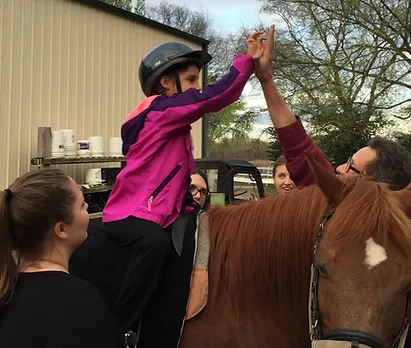
Discover the incredible benefits of Hippotherapy for children with autism and sensory processing difficulties. Join us as we explore the research behind this unique therapy.. Join us as we explore the research behind this unique therapy. This post was created by Marra Robert, OTD, OTR/L in April 2023 and updated in June 2023.

There has been a steady increase in the number of individuals diagnosed with Autism Spectrum Disorder (ASD) over recent years. There has also been an increase in knowledge about the diagnoses and a passion by many individuals to seek more awareness and acceptance of this disorder.
ASD is a broad diagnosis and can present itself in many unique ways. A few of the common challenges of those with ASD include social skills, communication, motor control, and cognitive challenges. One of the most common challenges people with ASD experience is sensory processing difficulties, which may also underlie some of the other challenges faced.
Hippotherapy for Children with Autism and Sensory Processing
Sensory processing is our brain’s ability to process incoming sensory information. We use our senses and incoming information to understand our bodies and the world around us (Dunn, 2009). We have eight senses that collect incoming information from the outside world: our visual, tactile, auditory, oral, olfactory, vestibular, interoception, and proprioceptive senses.
The vestibular sense is our sense of balance and movement. Proprioception is the sense of joint position and where our body parts are in space. Our brain needs to receive and process incoming information to understand the world around us in order to choose appropriate actions (Dunn, 2009).
People respond to incoming sensory information differently. The brain operates based on a threshold in regard to incoming sensory information (Dunn, 2009). When someone has a low threshold, their brain notices sensory information very quickly (Dunn, 2009). With a high threshold, it takes a lot of incoming sensory information in order to generate a response.
People vary with their levels of thresholds; however, if their sensory threshold is very high or very low compared to the amount and type of sensory input in their environments, it might impact their daily activities. Children who struggle to process sensory information often have a difficult time choosing appropriate actions and, therefore often demonstrate negative behaviors.
As the number of those diagnosed with ASD increases, so has the curiosity of therapists and researchers to examine the different intervention techniques that may help those with ASD take on the challenges they face, and meet their goals. There is a growing amount of research to support the use of hippotherapy as an intervention tool when working with clients with ASD.
Using Hippotherapy to improve sensory processing skills

Hippotherapy is very beneficial for those who struggle with sensory processing. The horse and the environment of an EAT session is a multi-sensory system that often calms the sensory systems of clients (Bass et al., 2009).
The environment of the hippotherapy treatment session is unlike any other traditional therapy clinic. Hippotherapy occurs outside or in a barn with natural or artificial lighting with animals, and a wide variety of textures and smells. This often calms the sensory system and at the same time challenges it.
The repetitive rhythmic movement of the horse may have a calming effect on the client or may stimulate depending on the client’s threshold. Many of the sensory systems are challenged at the same time during the intervention by the movement and feel of the horse, the treatment environment as well as participation in activities while on the horse.
Due to the repetitive rhythmic movement of the horse’s gait, the client’s vestibular system is constantly being challenged. Research has shown that both motor planning and intellectual abilities can be positively stimulated (Cuypers et al., 2011).
Difficulties with sensory processing may lead to anxiety. In a hippotherapy session, the connection formed and the human-equine interaction often creates a calming effect decreasing anxiety in many individuals (Gabriels et al., 2015).
By strengthening clients’ ability to process varied sensory information, EAT can be used to improve participation in daily activities for clients. Simply being around the horse, whether mounted or not, is often calming to the sensory systems and can increase clients’ sensory processing. The activities to the right may provide additional sensory inputs and benefits to address the various needs and goals of our unique clients.
Learn more about the research that supports the use of hippotherapy when working with clients with ASD and sensory processing difficulties.

